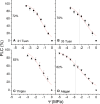Stomatal Sensitivity to Vapor Pressure Deficit and the Loss of Hydraulic Conductivity Are Coordinated in Populus euphratica, a Desert Phreatophyte Species
- PMID: 32922423
- PMCID: PMC7456922
- DOI: 10.3389/fpls.2020.01248
Stomatal Sensitivity to Vapor Pressure Deficit and the Loss of Hydraulic Conductivity Are Coordinated in Populus euphratica, a Desert Phreatophyte Species
Abstract
There are considerable variations in the percentage loss of hydraulic conductivity (PLC) at mid-day minimum water potential among and within species, but the underpinning mechanism(s) are poorly understood. This study tested the hypothesis that plants can regulate leaf specific hydraulic conductance (K l) via precise control over PLC under variable ΔΨ (water potential differential between soil and leaf) conditions to maintain the -m/b constant (-m: the sensitivity of stomatal conductance to VPD; b: reference stomatal conductance at 1.0 kPa VPD), where VPD is vapor pressure deficit. We used Populus euphratica, a phreatophyte species distributed in the desert of Northwestern China, to test the hypothesis. Field measurements of VPD, stomatal conductance (g s), g s responses to VPD, mid-day minimum leaf water potential (Ψ lmin), and branch hydraulic architecture were taken in late June at four sites along the downstream of Tarim River at the north edge of the Taklamakan desert. We have found that: 1) the -m/b ratio was almost constant (=0.6) across all the sites; 2) the average Ψ 50 (the xylem water potential with 50% loss of hydraulic conductivity) was -1.63 MPa, and mid-day PLC ranged from 62 to 83%; 3) there were tight correlations between Ψ 50 and wood density/leaf specific hydraulic conductivity (k l) and between specific hydraulic conductance sensitivity to water potential [d(k s)/dln(-Ψ)] and specific hydraulic conductivity (k s). A modified hydraulic model was applied to investigate the relationship between g s and VPD under variable ΔΨ and K l conditions. It was concluded that P. euphratica was able to control PLC in order to maintain a relatively constant -m/b under different site conditions. This study demonstrated that branchlet hydraulic architecture and stomatal response to VPD were well coordinated in order to maintain relatively water homeostasis of P. euphratica in the desert. Model simulations could explain the wide variations of PLC across and within woody species that are often observed in the field.
Keywords: hydraulic model; leaf specific hydraulic conductance; stomatal conductance; water homeostasis; xylem cavitation.
Copyright © 2020 Fan, Dang, Xu, Jiang, Zhang, Xu, Yang and Zhang.
Figures






Similar articles
-
Nitrogen deposition increases xylem hydraulic sensitivity but decreases stomatal sensitivity to water potential in two temperate deciduous tree species.Sci Total Environ. 2022 Nov 20;848:157840. doi: 10.1016/j.scitotenv.2022.157840. Epub 2022 Aug 5. Sci Total Environ. 2022. PMID: 35934026
-
Further insights into the components of resistance to Ophiostoma novo-ulmi in Ulmus minor: hydraulic conductance, stomatal sensitivity and bark dehydration.Tree Physiol. 2018 Feb 1;38(2):252-262. doi: 10.1093/treephys/tpx123. Tree Physiol. 2018. PMID: 29040781
-
Environmental and physiological regulation of transpiration in tropical forest gap species: the influence of boundary layer and hydraulic properties.Oecologia. 1995 Apr;101(4):514-522. doi: 10.1007/BF00329432. Oecologia. 1995. PMID: 28306968
-
Water relations in tree physiology: where to from here?Tree Physiol. 2017 Jan 31;37(1):18-32. doi: 10.1093/treephys/tpw102. Tree Physiol. 2017. PMID: 28173481 Review.
-
Systemic effects of rising atmospheric vapor pressure deficit on plant physiology and productivity.Glob Chang Biol. 2021 May;27(9):1704-1720. doi: 10.1111/gcb.15548. Epub 2021 Mar 8. Glob Chang Biol. 2021. PMID: 33683792 Free PMC article. Review.
Cited by
-
High-Temperature and Drought Stress Effects on Growth, Yield and Nutritional Quality with Transpiration Response to Vapor Pressure Deficit in Lentil.Plants (Basel). 2021 Dec 28;11(1):95. doi: 10.3390/plants11010095. Plants (Basel). 2021. PMID: 35009098 Free PMC article.
-
PtrVCS2 Regulates Drought Resistance by Changing Vessel Morphology and Stomatal Closure in Populus trichocarpa.Int J Mol Sci. 2023 Feb 24;24(5):4458. doi: 10.3390/ijms24054458. Int J Mol Sci. 2023. PMID: 36901889 Free PMC article.
References
-
- Bruelheide H., Jandt U. (2004). “Vegetation types in the foreland of the Qira Oasis: present distribution and changes during the last decades,” in Ecophysiology and Habitat Requirements of Perennial Species in the Taklimakan Desert. Eds. Runge M., Zhang X. (Aachen, Germany: Shaker; ), 27–34.
-
- Bruelheide H., Jandt U., Gries D., Thomas F. M., Foetzki A., Buerkert A., et al. (2003). Vegetation changes in a river oasis on the southern rim of the Taklamakan Desert in China between 1956 and 2000. Phytocoenologia 33, 801–818. 10.1127/0340-269X/2003/0033-0801 - DOI
-
- Bucci S. J., Goldstein G., Meinzer F. C., Franco A. C., Campanello P., Scholz F. G. (2005). Mechanisms contributing to seasonal homeostasis of minimum leaf water potential and predawn disequilibrium between soil and plant water potential in Neotropical savanna trees. Trees 19, 296–304. 10.1007/s00468-004-0391-2 - DOI
-
- Bucci S. J., Scholz F. G., Peschiutta M. L., Arias N. S., Meinzer F. C., Goldstein G. (2013). The stem xylem of P atagonian shrubs operates far from the point of catastrophic dysfunction and is additionally protected from drought-induced embolism by leaves and roots. Plant Cell Environ. 36, 2163–2174. 10.1111/pce.12126 - DOI - PubMed
LinkOut - more resources
Full Text Sources
Miscellaneous

